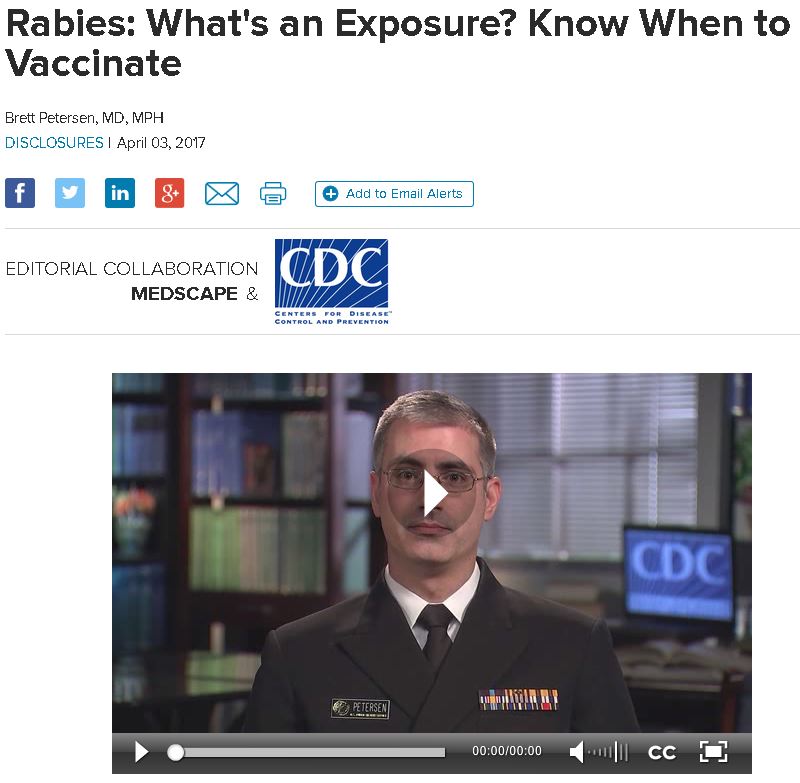Watch the video & take notes on a sheet of paper
Once you have registered on Medscape, reach the page http://www.medscape.com/viewarticle/877636
When you have finished, click on each item below to see the answer.

Rabies: What’s an Exposure? Know When to Vaccinate – Medscape – Apr 03, 2017.
- How to assess potential exposure to determine whether rabies postexposure prophylaxis is needed
- How to effectively administer PEP to prevent rabies virus from infecting the patient
- ≈ always fatal after symptoms have developed
- No proven treatment exists → prevention is so critical
- Human rabies is rare in US, thanks to high vaccination rates among domestic animals & effective animal control programs
- Exposures to rabies virus are common, ≈ 40,000 people in US receive PEP following potential rabies virus exposures each year
- Consider whether exposure is a risk for rabies transmission
- Need for PEP is based on multiple factors (type of exposure, animal involved in exposure, laboratory & surveillance information for location where exposure occurred)
- First step: determine whether rabies virus exposure has occurred: bite of a rabid animal = most common & dangerous route of exposure
- Any penetration of skin by the animal's teeth to be considered a bite exposure
- Rabies virus can also be transmitted when saliva or other potentially infectious material is introduced into fresh, open cuts in the skin or onto the mucous membranes (e.g., rabies virus transmitted to transplant patients who received organs & tissues from donors who died of rabies
- Indirect contact with animals is not considered exposure and PEP is not recommended in these situations (petting or handling animal; contact with animal blood, urine, or feces; contact by saliva on intact skin)
- Depends on availability of animal for observation or rabies testing
- Healthy domestic dog, cat, or ferret that bites a person should be confined and observed for 10 days
• If animal develops signs of rabies while being observed, → initiate PEP & test animal for rabies
• If animal remains healthy after 10 days, PEP not needed ← animal not infectious at time of bite
- If exposure involves wild animal (bat, raccoon, skunk, or fox) give PEP in most cases unless animal is available for rapid laboratory testing or has already tested negative
- Any contact with bats should be evaluated carefully for exposure ← most cases of human rabies in US are linked with bats. Bites from bats may be relatively minor, so danger can be underappreciated or unrecognized
- Begin PEP with proper wound treatment
- Washing wound with soap & water can decrease chance for infection
- For previously unvaccinated persons, PEP = regimen of 1 dose of rabies immune globulin & 4 doses of rabies vaccine given over a 14-day period
- PEP also recommended for previously vaccinated persons who have had an exposure = 2 doses of rabies vaccine given on days 0 and 3
- If patients are worried ← heard that vaccinations are painful, reassure them that modern rabies vaccines are relatively painless, involve fewer shots than in the past, & are given in the arm, like a flu or tetanus vaccine - Rabies PEP = medical urgency, not emergency, but decision to administer PEP should be made quickly
- When in doubt, better to err on side of caution & begin PEP ← high fatality rate once symptoms appear
- Rabies PEP considered safe & 100% effective in preventing human rabies following an exposure when administered according to recommendations from CDC's Advisory Committee for Immunization Practices (ACIP)
- Local or state health department available for consultations & often best source for information on prevalence of rabies in your area. Detailed information on rabies is also available on CDC website
Demo Content
UNF3S
Route 66 to medical literature, Félicie Pastore 2017
